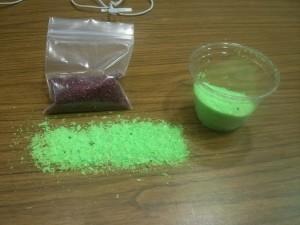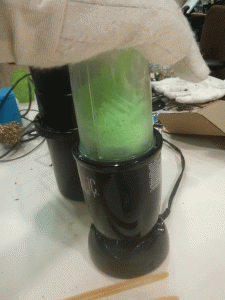The recycling of plastics and 3D printed objects is something that has garnered a ton of attention over the last year or two. With 3D printers becoming ever more popular, there are environmental consequences to the  increase of plastics being manufactured and subsequently thrown away in our landfills. This has led several groups to try and figure out a way in which unwanted 3D printed items, or even plastics we come upon in our daily lives, can easily be reused instead of trashed.
increase of plastics being manufactured and subsequently thrown away in our landfills. This has led several groups to try and figure out a way in which unwanted 3D printed items, or even plastics we come upon in our daily lives, can easily be reused instead of trashed.
In order to recycle PLA filament, one must first grind the filament up into tiny pieces. Once done, that filament can be placed into a plastic extruder, melted, and turned back into 3d printer filament. The problem is it often takes a tremendous amount of work and energy to chop the plastic up fine enough, mostly due to the fact that the PLA plastics absorb energy, making them difficult to break down.
This is why University of British Columbia students, with the UBC Rapid engineering design team, have been working to find a better way to grind plastics. They have  recently figured out a way to better grind up PLA 3D printer plastic via a household blender, by adding liquid nitrogen to the mix.
recently figured out a way to better grind up PLA 3D printer plastic via a household blender, by adding liquid nitrogen to the mix.
PLA plastic has a brittle transition temperature that is under -20 to -40C. This means that at those temperatures, the plastic loses most if its energy absorbtion properties, basically allowing it to shater as blender blades hit it. Liquid nitrogen has a temperature far colder (-196C) than the brittle transition temperature required, making it ideal for cooling the plastic. What the team at UBC Rapid did was cool the plastic with the liquid nitrogen, strain the liquid out of the plastic, place the plastic into a Magic Bullet blender, and blend away. The results were quite remarkable, leaving the team with an almost powder like material after only a few minutes in the blender. The blended material can then be placed into an extruder and made into filament for your favorite 3D printer.
There are some caveats here though. It is not easy to just go pick up liquid nitrogen. This is where dry ice could come into play. Although the ice is not as cold as the nitrogen, it is still well below the temperature needed to eliminate the energy absorbtion properties of the plastic. The other caveat is that temperatures this cold will also cause metals, like the blender blades, to become more brittle, leading to broken blades in some cases. Either way this research may pave the way towards a more large scale PLA recycling project. Discuss this unique approach to the recycling of PLA filament at 3D Print Board.
Subscribe to Our Email Newsletter
Stay up-to-date on all the latest news from the 3D printing industry and receive information and offers from third party vendors.
You May Also Like
Precision at the Microscale: UK Researchers Advance Medical Devices with BMF’s 3D Printing Tech
University of Nottingham researchers are using Boston Micro Fabrication‘s (BMF) 3D printing technology to develop medical devices that improve compatibility with human tissue. Funded by a UK grant, this project...
3D Printing Webinar and Event Roundup: April 21, 2024
It’s another busy week of webinars and events, starting with Hannover Messe in Germany and continuing with Metalcasting Congress, Chinaplas, TechBlick’s Innovation Festival, and more. Stratasys continues its advanced training...
3D Printing Webinar and Event Roundup: March 17, 2024
It’s another busy week of webinars and events, including SALMED 2024 and AM Forum in Berlin. Stratasys continues its in-person training and is offering two webinars, ASTM is holding a...
3D Printed Micro Antenna is 15% Smaller and 6X Lighter
Horizon Microtechnologies has achieved success in creating a high-frequency D-Band horn antenna through micro 3D printing. However, this achievement did not rely solely on 3D printing; it involved a combination...





























